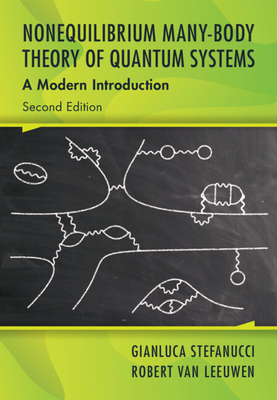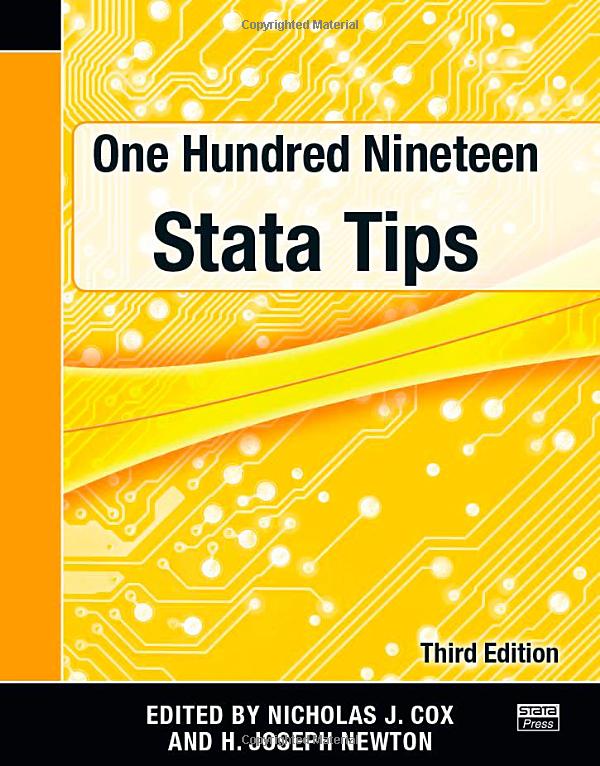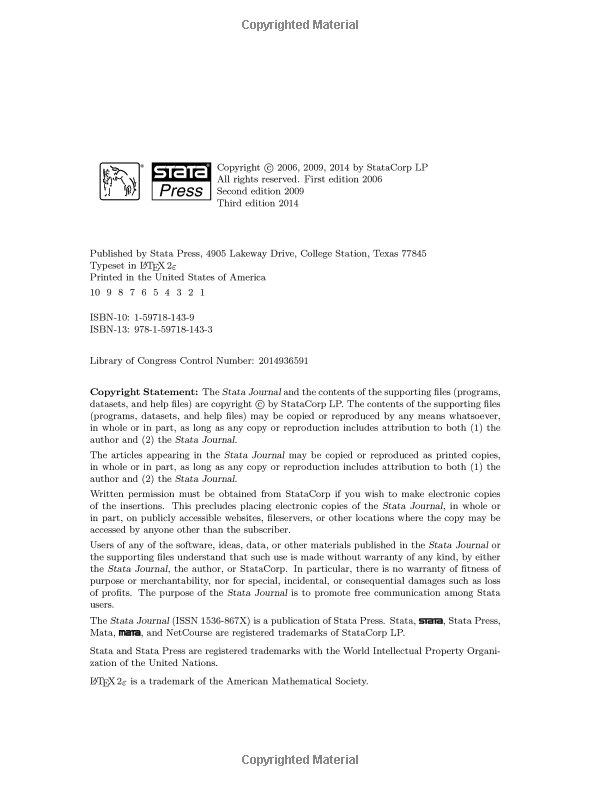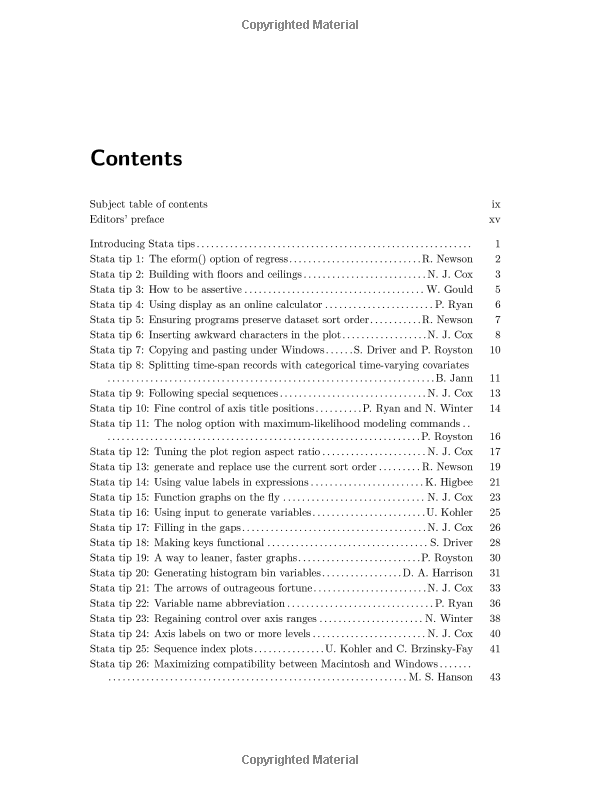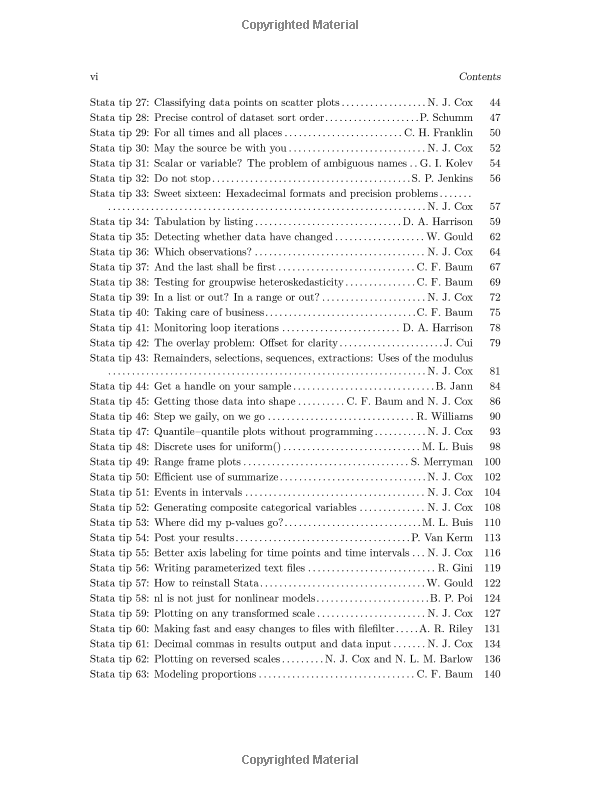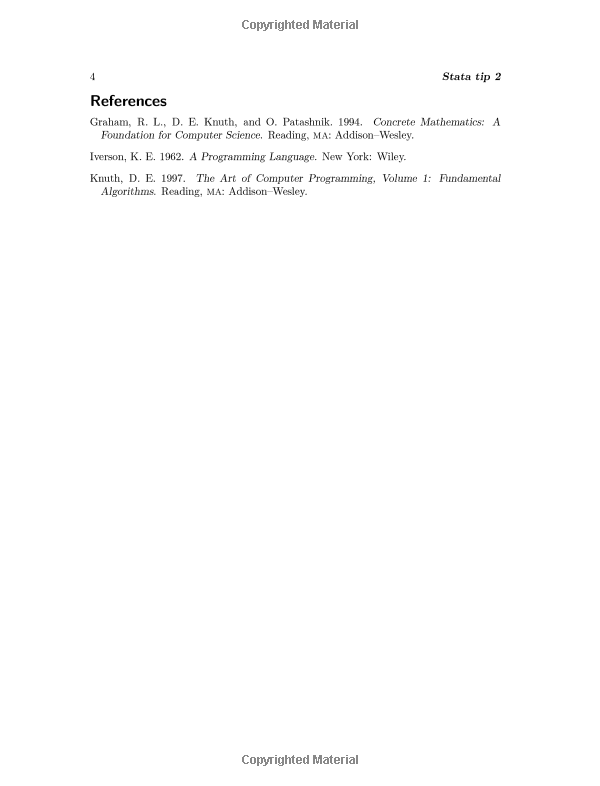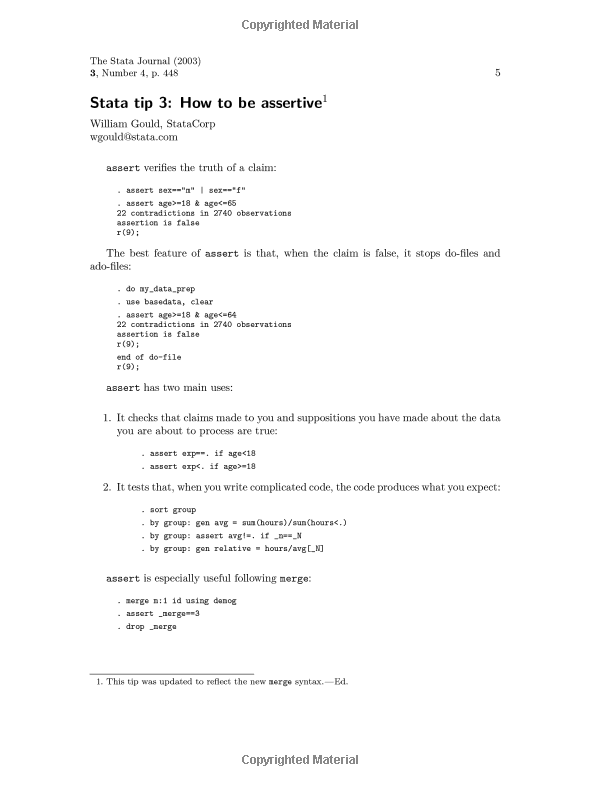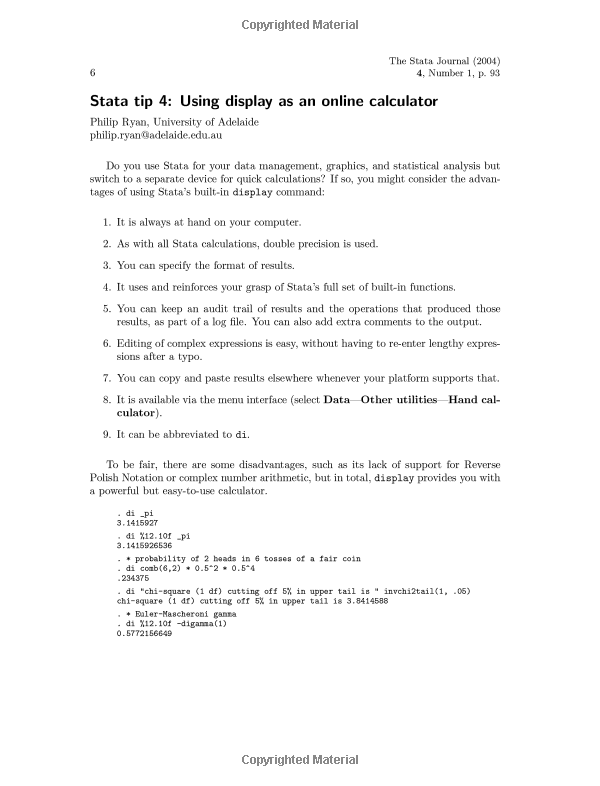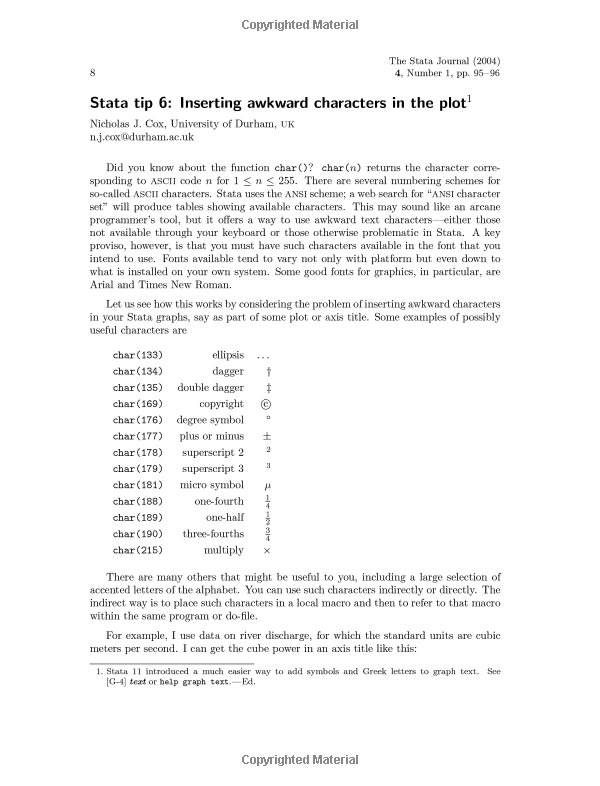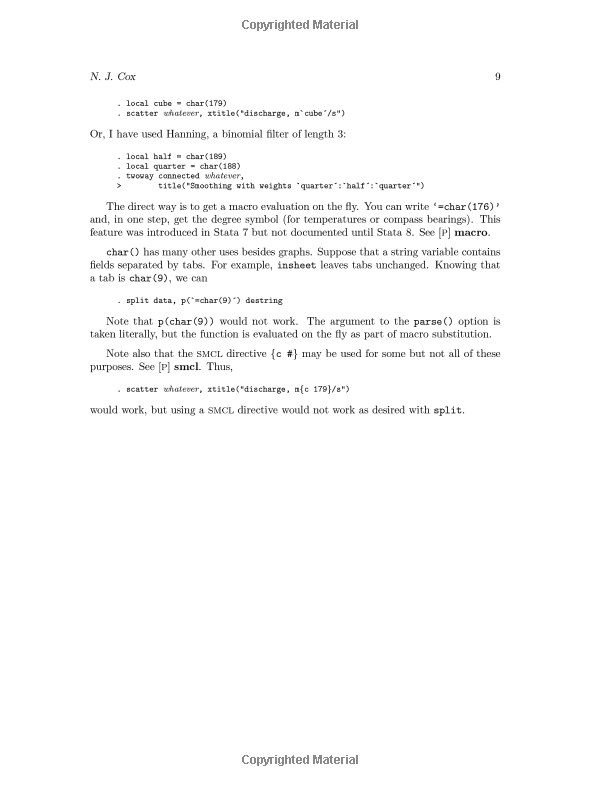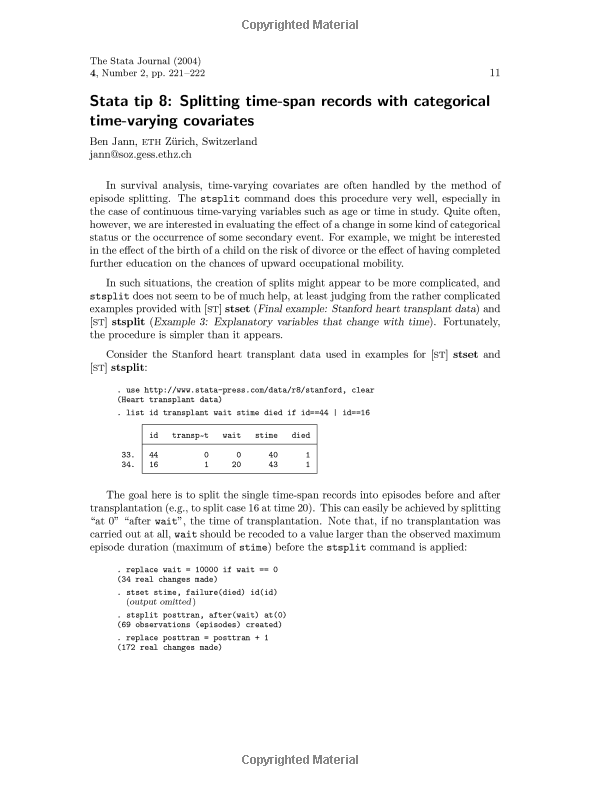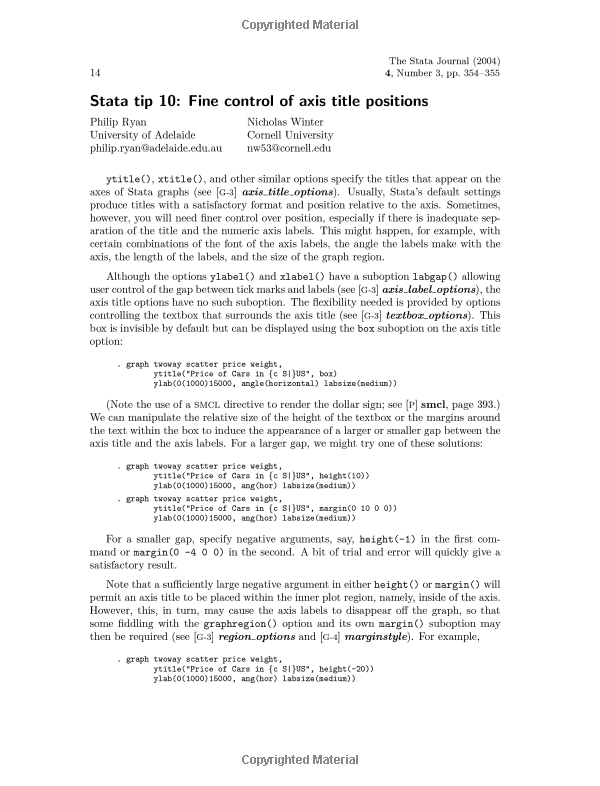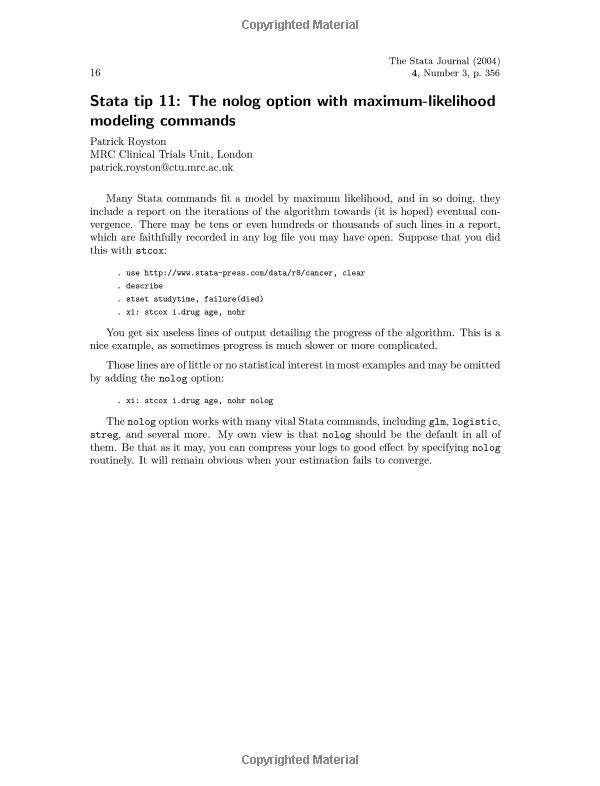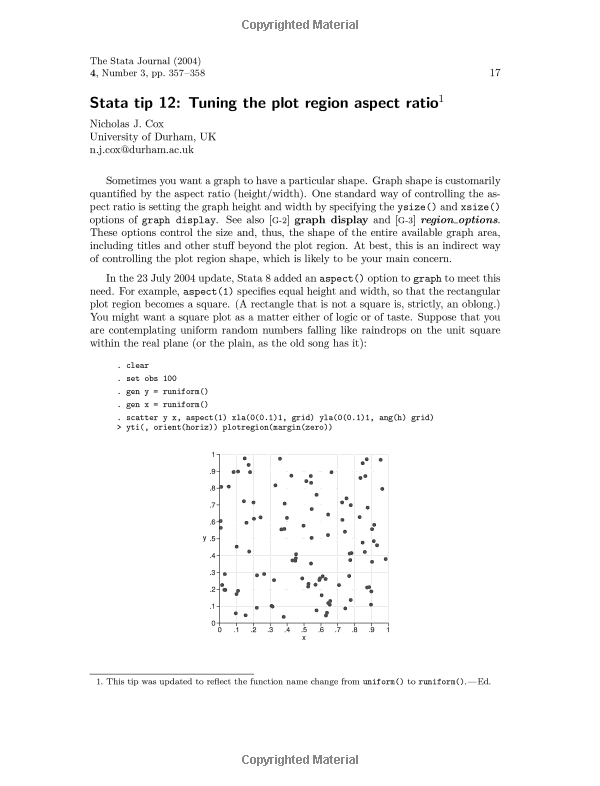图书简介
One Hundred Nineteen Stata Tips provides concise and insightful notes about commands, features, and tricks that will help you obtain a deeper understanding of Stata. The book comprises the contributions of the Stata community that have appeared in the Stata Journal since 2003.
Introducing Stata tips. Stata tip 1: The eform() option of regress. Stata tip 2: Building with floors and ceilings. Stata tip 3: How to be assertive. Stata tip 4: Using display as an online calculator. Stata tip 5: Ensuring programs preserve dataset sort order. Stata tip 6: Inserting awkward characters in the plot. Stata tip 7: Copying and pasting under Windows. Stata tip 8: Splitting time-span records with categorical time-varying covariates. Stata tip 9: Following special sequences. Stata tip 10: Fine control of axis title positions. Stata tip 11: The nolog option with maximum-likelihood modeling commands. Stata tip 12: Tuning the plot region aspect ratio. Stata tip 13: generate and replace use the current sort order. Stata tip 14: Using value labels in expressions. Stata tip 15: Function graphs on the fly. Stata tip 16: Using input to generate variables. Stata tip 17: Filling in the gaps. Stata tip 18: Making keys functional. Stata tip 19: A way to leaner, faster graphs. Stata tip 20: Generating histogram bin variables. Stata tip 21: The arrows of outrageous fortune. Stata tip 22: Variable name abbreviation. Stata tip 23: Regaining control over axis ranges. Stata tip 24: Axis labels on two or more levels. Stata tip 25: Sequence index plots. Stata tip 26: Maximizing compatibility between Macintosh and Windows. Stata tip 27: Classifying data points on scatter plots. Stata tip 28: Precise control of dataset sort order. Stata tip 29: For all times and all places. Stata tip 30: May the source be with you. Stata tip 31: Scalar or variable? The problem of ambiguous names. Stata tip 32: Do not stop. Stata tip 33: Sweet sixteen: Hexadecimal formats and precision problems. Stata tip 34: Tabulation by listing. Stata tip 35: Detecting whether data have changed. Stata tip 36: Which observations? Stata tip 37: And the last shall be first. Stata tip 38: Testing for groupwise heteroskedasticity. Stata tip 39: In a list or out? In a range or out? Stata tip 40: Taking care of business. Stata tip 41: Monitoring loop iterations. Stata tip 42: The overlay problem: Offset for clarity. Stata tip 43: Remainders, selections, sequences, extractions: Uses of the modulus. Stata tip 44: Get a handle on your sample. Stata tip 45: Getting those data into shape. Stata tip 46: Step we gaily, on we go. Stata tip 47: Quantile?quantile plots without programming. Stata tip 48: Discrete uses for uniform(). Stata tip 49: Range frame plots. Stata tip 50: Efficient use of summarize. Stata tip 51: Events in intervals. Stata tip 52: Generating composite categorical variables. Stata tip 53: Where did my p-values go? Stata tip 54: Post your results. Stata tip 55: Better axis labeling for time points and time intervals. Stata tip 56: Writing parameterized text files. Stata tip 57: How to reinstall Stata. Stata tip 58: nl is not just for nonlinear models. Stata tip 59: Plotting on any transformed scale. Stata tip 60: Making fast and easy changes to files with filefilter. Stata tip 61: Decimal commas in results output and data input. Stata tip 62: Plotting on reversed scales. Stata tip 63: Modeling proportions. Stata tip 64: Cleaning up user-entered string variables. Stata tip 65: Beware the backstabbing backslash. Stata tip 66: ds?A hidden gem. Stata tip 67: J() now has greater replicating powers. Stata tip 68: Week assumptions. Stata tip 69: Producing log files based on successful interactive commands. Stata tip 70: Beware the evaluating equal sign. Stata tip 71: The problem of split identity, or how to group dyads. Stata tip 72: Using the Graph Recorder to create a pseudograph scheme. Stata tip 73: append with care! Stata tip 74: firstonly, a new option for tab2. Stata tip 75: Setting up Stata for a presentation. Stata tip 76: Separating seasonal time series. Stata tip 77: (Re)using macros in multiple do-files. Stata tip 78: Going gray gracefully: Highlighting subsets and downplaying substrates. Stata tip 79: Optional arguments to options. Stata tip 80: Constructing a group variable with specified group sizes. Stata tip 81: A table of graphs. Stata tip 82: Grounds for grids on graphs. Stata tip 83: Merging multilingual datasets. Stata tip 84: Summing missings. Stata tip 85: Looping over nonintegers. Stata tip 86: The missing() function. Stata tip 87: Interpretation of interactions in nonlinear models. Stata tip 88: Efficiently evaluating elasticities with the margins command. Stata tip 89: Estimating means and percentiles following multiple imputation. Stata tip 90: Displaying partial results. Stata tip 91: Putting unabbreviated varlists into local macros. Stata tip 92: Manual implementation of permutations and bootstraps. Stata tip 93: Handling multiple y axes on twoway graphs. Stata tip 94: Manipulation of prediction parameters for parametric survival regression. Stata tip 95: Estimation of error covariances in a linear model. Stata tip 96: Cube roots. Stata tip 97: Getting at ??s and ??s. Stata tip 98: Counting substrings within strings. Stata tip 99: Taking extra care with encode. Stata tip 100: Mata and the case of the missing macros. Stata tip 101: Previous but different. Stata tip 102: Highlighting specific bars. Stata tip 103: Expressing confidence with gradations. Stata tip 104: Added text and title options. Stata tip 105: Daily dates with missing days. Stata tip 106: With or without reference. Stata tip 107: The baseline is now reported. Stata tip 108: On adding and constraining. Stata tip 109: How to combine variables with missing values. Stata tip 110: How to get the optimal k-means cluster solution. Stata tip 111: More on working with weeks. Stata tip 112: Where did my p-values go? (Part 2) Stata tip 113: Changing a variable?s format: What it does and does not mean. Stata tip 114: Expand paired dates to pairs of dates. Stata tip 115: How to properly estimate the multinomial probit model with heteroskedastic errors. Stata tip 116: Where did my p-values go? (Part 3). Stata tip 117: graph combine?Combining graphs. Stata tip 118: Orthogonalizing powered and product terms using residual centering. Stata tip 119: Expanding datasets for graphical ends.
Trade Policy 买家须知
- 关于产品:
- ● 正版保障:本网站隶属于中国国际图书贸易集团公司,确保所有图书都是100%正版。
- ● 环保纸张:进口图书大多使用的都是环保轻型张,颜色偏黄,重量比较轻。
- ● 毛边版:即书翻页的地方,故意做成了参差不齐的样子,一般为精装版,更具收藏价值。
关于退换货:- 由于预订产品的特殊性,采购订单正式发订后,买方不得无故取消全部或部分产品的订购。
- 由于进口图书的特殊性,发生以下情况的,请直接拒收货物,由快递返回:
- ● 外包装破损/发错货/少发货/图书外观破损/图书配件不全(例如:光盘等)
并请在工作日通过电话400-008-1110联系我们。
- 签收后,如发生以下情况,请在签收后的5个工作日内联系客服办理退换货:
- ● 缺页/错页/错印/脱线
关于发货时间:- 一般情况下:
- ●【现货】 下单后48小时内由北京(库房)发出快递。
- ●【预订】【预售】下单后国外发货,到货时间预计5-8周左右,店铺默认中通快递,如需顺丰快递邮费到付。
- ● 需要开具发票的客户,发货时间可能在上述基础上再延后1-2个工作日(紧急发票需求,请联系010-68433105/3213);
- ● 如遇其他特殊原因,对发货时间有影响的,我们会第一时间在网站公告,敬请留意。
关于到货时间:- 由于进口图书入境入库后,都是委托第三方快递发货,所以我们只能保证在规定时间内发出,但无法为您保证确切的到货时间。
- ● 主要城市一般2-4天
- ● 偏远地区一般4-7天
关于接听咨询电话的时间:- 010-68433105/3213正常接听咨询电话的时间为:周一至周五上午8:30~下午5:00,周六、日及法定节假日休息,将无法接听来电,敬请谅解。
- 其它时间您也可以通过邮件联系我们:customer@readgo.cn,工作日会优先处理。
关于快递:- ● 已付款订单:主要由中通、宅急送负责派送,订单进度查询请拨打010-68433105/3213。
本书暂无推荐
本书暂无推荐

